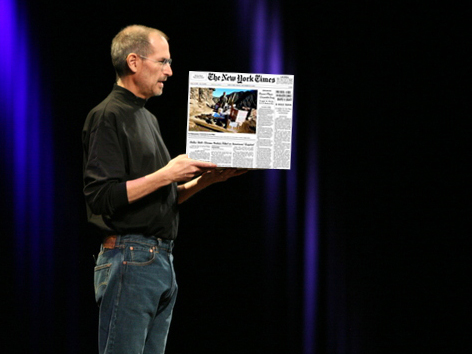
Steve Jobs holding a copy of newly-acquired New York Times
OK, not really. But imagine if you woke up this morning, glanced at the headlines and saw that this HAD happened? If Steve Jobs HAD purchased the New York Times. Now imagine what kind of changes we’d expect to see at the New York Times (or insert any large, ailing newspaper). One thing is for sure, we would cease to see business as usual.
The New York Times would change. And not only would the paper itself change, the industry in general would change with it.
I got to thinking about this after I published my entry The End of Print, As We Know It as well as after publishing Mobile Phones FINALLY Get Smart — Kinda. Think about the backwards, plodding, change-averse U.S. mobile industry before the iPhone was released 1 1/2 years ago. Mobile technology had made shockingly little progress when compared to the pace of technological innovation in most other industries and certainly when compared to the mobile industries in Europe and Asia. The iPod was a jolt to the system of the plodding mobile industry, much as the iPod had been to the portable digital music industry in 2001.
The newspaper industry is every bit as slow, plodding and change-averse as the U.S. mobile industry was. Maybe more so. Faced with substantial changes or death, it would seem that the industry has chosen the latter, as the steep dive in U.S. circulations may only be rivaled by the steep declines in newspaper profits.
What if Steve Jobs bought the New York Times?
I suppose one of the first things to change would be the web site. Don’t get me wrong, the New York Times web site is far from poorly-designed. I personally love the use of technology and white space. But as a fan of the printed version of the newspaper, I can’t help feel that one of the best aspects of the New York Times web site is the fact that it does a very good job of mimicing the look and feel of its printed counterpart. This may be its biggest downfall.
The New York Times newspaper works very well in the medium for which it was designed. Print. To handcuff the web site and tether it so closely to the printed newspaper is to ignore the realities of the medium for which IT is intended The dgital space.
For instance, why can’t I rearrange elements on the NYT home page like I can with my iGoogle? If I want MY version of the Times to lead with sports, politics and weather I should have that choice. That type of customization on web sites is very common now and users will not tolerate information being served to them in cookie-cutter fashion.

Today's NYTimes.com front page
Another thing would I guess be conversational features. Why is it that I cannot comment on Times articles? Some newspaper web sites are starting to allow this type of user feedback but that type of progress is generally slow going.
Mobile Integration
I would have to imagine another change would be to improve the mobile integration of the NYTimes.com site. I have the iPhone app and while I admire the Times’ ambition in being the first major newspaper to have one, the app has always suffered from being a bit slow and buggy. It crashes far more than its AP counterpart. Still, I think the iPhone app is a good start but I’d like to see more, far more. Mobile social features would be nice. For instance, it would be great to read an article on the iPhone app and Digg it right from my phone. How about ratings? How great would it be to be able to rate an article from my phone? Better yet, how about combine the two? Perhaps I could customize my home page to auto-populate a section of articles that are highly-rated by users who preferences match my own? Who have highly-rated similar articles that I have highly-rated?

NYTimes iPhone App
Other Features
In my “End of Print” entry, I asked why it was that newspapers like the New York Times hadn’t innovated technologies like Craig’s List and eBay? For that matter, why not Rotten Tomatoes, the online movie ratings aggregator? Or perhaps a location-based mobile application that lets you know where the most highly-rated restaurants on the New York Times list are, while you’re out on the town?
And by the way, it’s not like I’m picking on the New York Times. It’s my favorite paper. One could substitute its name for any major newspaper and I’m pretty sure my observations would still apply.
Maybe to have one of them bought by Steve Jobs is what they ALL need? Might be the only thing that could save the ailing newspaper industry, or maybe it’s too much even for him?
.chris{}
























































































